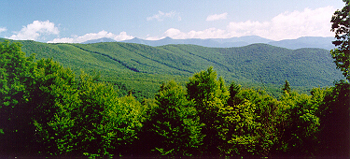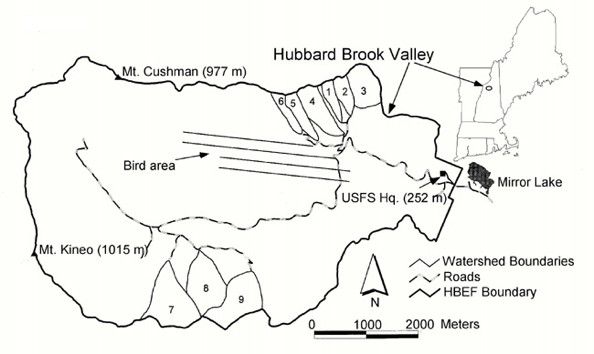Study Site
| |

Hubbard Brook Experimental
Forest (photo provided by the Hubbard Brook Research Foundation). |
This study was conducted within the Hubbard
Brook Experimental Forest, a 3,160 hectare (about 7,800 acres) reserve
within the White Mountains of New Hampshire. Hubbard Brook is known
throughout the scientific community for being part of a network of
LTER (Long-Term Ecological Research) sites, which are funded by the
National Science Foundation to conduct research on ecological processes
across broad spatial scales and over long periods of time. The collective
efforts of hundreds of researchers have generated a tremendous amount
of long-term data on the hydrology of the region, the cycling of important
nutrients like nitrogen and carbon, the impacts of disturbance events
(e.g. ice storms), the causes and consequences of fluctuations in
plant and animal populations, and many other facets of the ecosystem
at Hubbard Brook. The research that has been conducted on Black-throated
Blue Warblers has contributed to, and benefited from, the collective
knowledge of ecological processes at the site.
The "bird research area" is
just over a mile past Mirror Lake and the building that houses the
Hubbard Brook Headquarters (see map below). In 1969, Dr. Richard Holmes
of Dartmouth College established a 10 ha (almost as big as 19 football
fields) study plot in that area and began monitoring the bird community,
going back each year to count all of the birds on the plot. That is,
he counted every individual of every species! After getting some information
on the community as a whole, he and his colleagues decided to focus
more intently on the population ecology of one species - the Black-throated
Blue Warbler. The 10 ha study plot was expanded to 64 ha (about the
size of 120 football fields), and since 1986 all of the Black-throated
Blue Warblers on the plot have been monitored to measure the average
number of young each pair produced each year in relation to the environmental
factors that affect warbler nesting success (predator abundance, food
availability, density).

Map of the Hubbard Brook
Experimental Forest, showing its location within New Hampshire
(see inset) as well as the location of the "bird area"
within the reserve boundaries (note dashed lines; map created
by R. Holmes). |